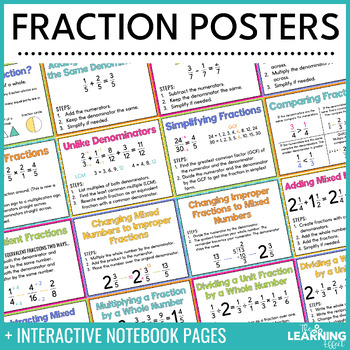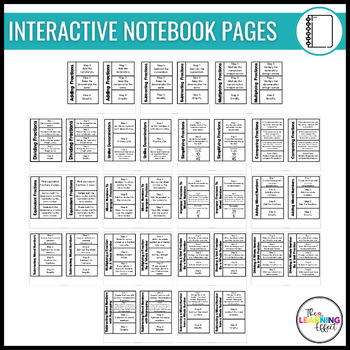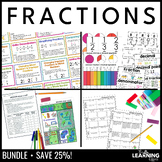Fraction Posters and Interactive Notebook Pages | Math Anchor Charts
- PDF
What educators are saying
Also included in
- If you teach fractions in upper elementary, this bundle of resources is just for you! This bundle is jam packed with posters, interactive notebook pages, games, activities, and more!Save 25% by purchasing five fraction resources in this money-saving bundle! Perfect for 4th, 5th, and 6th grade.THIS BPrice $15.25Original Price $20.50Save $5.25
Description
Fractions are a tough concept for students to grasp. There are so many different procedures to follow for unlike denominators, mixed numbers, improper fractions, and so on. These brightly colored fraction posters are perfect for student reference throughout the school year. The basics learned in 3rd grade through the more complex operations with fractions taught in 6th grade are included.
⭐ BUNDLE & SAVE ⭐
Save 25% by purchasing this resource in a bundle with my best-selling fraction resources
THIS RESOURCE INCLUDES
- 18 colorful posters with visuals and steps
- What is a fraction?
- Adding Fractions with the Same Denominators
- Subtracting Fractions with the Same Denominators
- Multiplying Fractions
- Dividing Fractions
- Unlike Denominators
- Simplifying Fractions
- Comparing Fractions
- Equivalent Fractions
- Changing Mixed Numbers to Improper Fractions (also has the option for the title 'Changing a Mixed Number to a Fraction Greater Than 1')
- Changing Improper Fractions to Mixed Numbers (also has the option for the title 'Changing a Fraction Greater Than 1 to a Mixed Number')
- Adding Mixed Numbers
- Subtracting Mixed Numbers
- Multiplying a Fraction by a Whole Number
- Dividing a Unit Fraction by a Whole Number
- Dividing a Whole Number by a Unit Fraction
- Subtracting Mixed Numbers with Regrouping (also has the option for the title 'Subtracting Mixed Numbers with Renaming')
- Subtracting a Mixed Number from a Whole Number
- Black and white ink-saving version of all posters
- Interactive notebook pages for each topic listed above (prints two per page)
- 'FRACTIONS' letters for bulletin board title
INCLUDED FILE FORMAT
- PDF: This resource requires Adobe Reader (free software). The contents may not show correctly if using other PDF software.
PLEASE NOTE
⚠️ The PDF is NOT editable in any way, and you will not be able to manipulate the content inside.
Fraction Resources
- Fractions Game Show | 4th Grade Math
- Convert and Simplify Fractions Bingo Game | Print + Digital Math Activity
- Fractions Math Mystery Picture + Digital Pixel Art Google Sheets Activity | FREE
CLICK HERE to follow The Learning Effect and be the first to know when NEW resources are added to my store!
New resources are always discounted for the first 48 hours.
CONNECT WITH ME
The Learning Effect Blog • Instagram • Facebook • Email Sign Up
Please ask ALL questions before purchasing.
© The Learning Effect, LLC | Tiffany Schmidt
All rights reserved by author.
Permission to copy for single classroom use only.
Please purchase additional licenses at a discounted rate for additional users.
Intended for classroom and personal use only.






